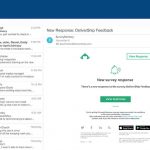Surveys are a great way to uncover situations that require immediate, personalized attention. However, when surveys are used on a broad scale, distributing feedback can become a bottleneck that gets in the way of taking action.
For companies that rely on surveys to guide decisions and track the customer experience, the process of collecting and distributing feedback needs to be automated and friction free. Companies need to focus not only on survey collection, but also on how, when, and where teams receive collected data, to ensure they can take action in a timely and appropriate way.
Pain points of distributing feedback
Without automation, managing large amounts of feedback can be a time-consuming, manual process. As a survey response comes in, there’s no way of knowing whether it’s positive, negative, or time-sensitive, unless an administrator is continually monitoring and triaging the data. In addition, it can be challenging to distribute critical feedback to the right stakeholders in a timely manner, and usually requires switching between the survey platform and communication apps, like Slack or email clients.
For example, a company who wants to evaluate their training programs might have a survey collector for each instructor, and send a survey to each student. In order to manage and act on the responses that flow in every day, an administrator would manually scroll through the feedback, identify negative responses, filter them to isolate the feedback, and send an email to the trainer to flag the issue.
Scale that process to support multiple trainers, students, and courses and it’s easy to see how taking action on feedback can get bogged down when the volume goes up.
Here are a few challenges companies face when distributing feedback:
- Sharing responses is a manual process
- Workflows can be complex
- Not everyone has access to the survey platform to see feedback
- Someone needs to continually monitor and triage responses
- It’s time-consuming to switch between survey platform and apps
And here’s what it looks like for their customers:
- No problem resolution
- Slow to respond
- “Too little too late” follow-up
- Poor customer service perception
Getting data into the right hands at the right time
Smart Notifications help empower organizations to immediately act on feedback, at scale. As survey usage grows and workflows become complex, Smart Notifications automate the feedback loop, and help teams manage large amounts of data without relying on manual, time-consuming processes.
With Smart Notifications, survey owners can set up conditions to trigger emails–either to themselves or stakeholders–that tell them they need to read feedback or take action based on a specific response.
For example, customer care teams can add Smart Notifications to an NPS survey so that detractor feedback is flagged and the right team member gets notified. A promoter response would trigger a notification to the marketing or customer advocacy team, to flag the opportunity for a case study or testimonial.
Using logic-based rules, surveys can be set up to send different Smart Notification emails to different people; up to 10 rules per survey. Notifications can be triggered based on survey questions and answers or respondent custom data, so people are flagged when a certain term is used.
For customer support teams, a Smart Notification could be triggered when specific keywords are submitted in open-ended questions. Words such as “bug” could trigger a notification and route the survey response to the QA team. Each Smart Notification email includes a link to the individual survey response, so stakeholders who are notified can see the response in a single click.
3 benefits of automating feedback distribution
1. Create a data-driven culture
Putting data in the hands of stakeholders who can make a difference is the first step to creating a data-driven culture. And, helping teams act quickly on feedback can have immediate results on your business–from improving NPS to more efficient customer interactions.
2. Eliminate manual processes and bottlenecks
Setting up Smart Notifications ensures survey data flows through the organization in a timely way. Instead of logging into SurveyMonkey after a survey is set up, reading through responses, and manually curating feedback, administrators can operationalize the process, quickly deliver insights, and focus their attention on taking action.
3. Include more stakeholders in the process
Data often needs to be shared with individuals and teams that don’t have access to the same survey platform. Smart Notification recipients don’t need a SurveyMonkey account to receive and access the individual survey responses linked in the emails. You can even notify recipients outside of your group or company, as long as they have an email address.
Feedback has the biggest impact when it’s shared and acted on. Find out how to automate feedback distribution and help teams take action.



